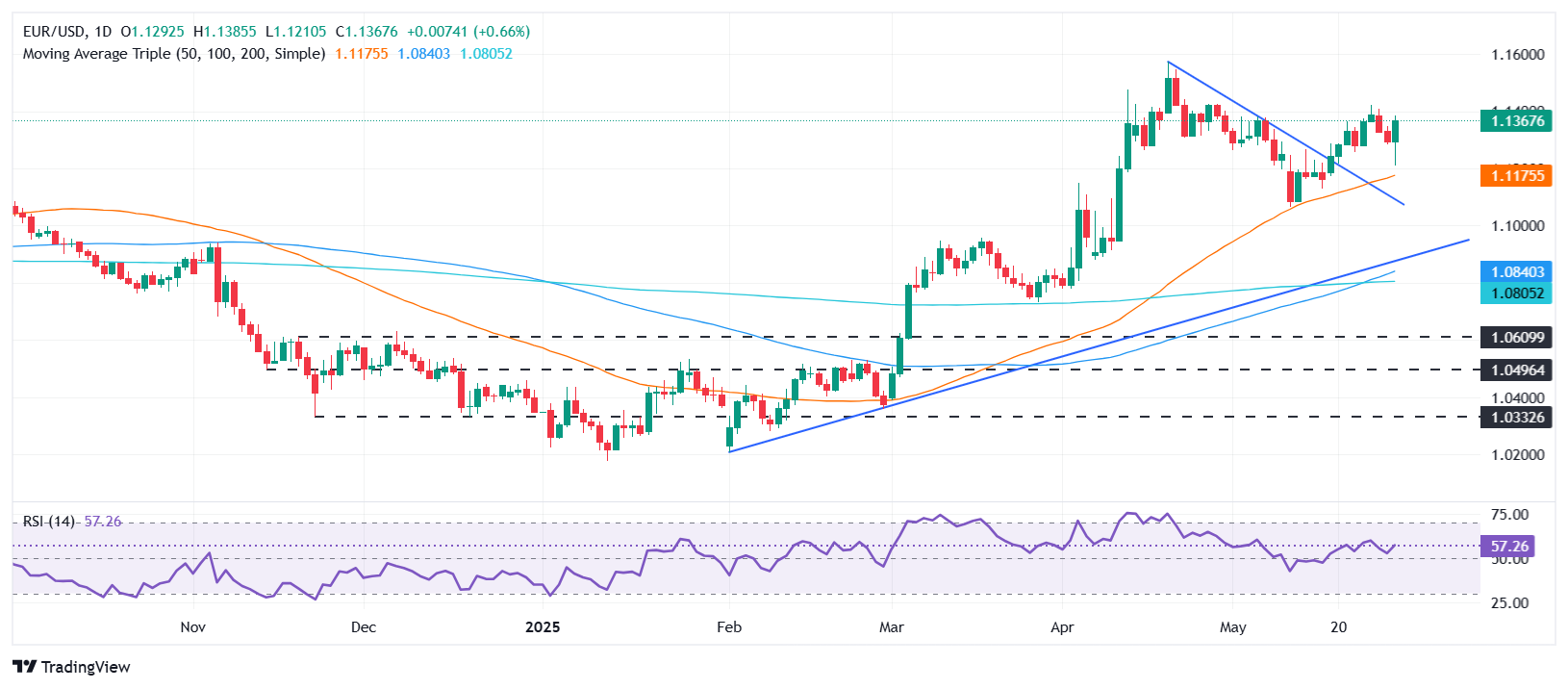- The EUR/USD rally sponsored by the increase in unemployment applications in the US, the US Q1 GDP confirms contraction.
- The markets now discount almost 50 basic points of fed cuts by the end of the year in weak data.
- The operators are attentive to the underlying PCE data on Friday; German and Italian inflation will guide the next movement of the euro.
The EUR/USD is recovered after reaching a weekly minimum of 1,1210, rising more than 0.70% on Thursday, since the US economic data of the United States (USA) were weaker, weakening the US dollar, which is also affected by the fall in returns in the US at the time of writing, the par quotes in 1,1376.
The US economic agenda revealed that Americans who request unemployment benefits increased in the week that ended on May 24, according to the US Department of Labor. In addition, the confirmation of a contraction in the data of the Gross Domestic Product (GDP) for the Q1 of 2025 pressed the dollar and raised the EUR/USD above the figure of 1,1300.
After the publication of the data, the operators discounted almost two cuts of 25 basic points (PBS) in the interest rates for the end of the year, according to the Future Contract of the Fed Fund rate of December 2025.
Other data showed that pending housing sales in April fell to the largest extent since September 2022.
Meanwhile, the operators bought the dollar, which, according to the US dollar index (DXY), is below 0.57%, at 99.30.
On the other side of the Atlantic, the Economic Agenda of the Eurozone (EU) was calm today. However, it will charge impulse on Friday. Germany will release April retail sales and May inflation data. Italy will present inflation figures.
In the US, the EUR/USD operators will take signals from the Personal Consumer Expenses Index (PCE), the Fed Fed Fed Inflation Indicator, which is expected to be moderate moderately in April.
Euro price this week
The lower table shows the percentage of euro change (EUR) compared to the main currencies this week. Euro was the strongest currency in front of the Japanese yen.
| USD | EUR | GBP | JPY | CAD | Aud | NZD | CHF | |
|---|---|---|---|---|---|---|---|---|
| USD | -0.01% | 0.23% | 1.12% | 0.54% | 0.67% | 0.14% | 0.26% | |
| EUR | 0.01% | 0.25% | 1.18% | 0.55% | 0.68% | 0.16% | 0.28% | |
| GBP | -0.23% | -0.25% | 0.60% | 0.31% | 0.43% | -0.09% | 0.05% | |
| JPY | -1.12% | -1.18% | -0.60% | -0.58% | -0.47% | -1.03% | -0.87% | |
| CAD | -0.54% | -0.55% | -0.31% | 0.58% | 0.15% | -0.40% | -0.26% | |
| Aud | -0.67% | -0.68% | -0.43% | 0.47% | -0.15% | -0.56% | -0.39% | |
| NZD | -0.14% | -0.16% | 0.09% | 1.03% | 0.40% | 0.56% | 0.14% | |
| CHF | -0.26% | -0.28% | -0.05% | 0.87% | 0.26% | 0.39% | -0.14% |
The heat map shows the percentage changes of the main currencies. The base currency is selected from the left column, while the contribution currency is selected in the upper row. For example, if you choose the euro of the left column and move along the horizontal line to the US dollar, the percentage change shown in the box will represent the EUR (base)/USD (quotation).
Daily market movements EUR/USD: Rallies in the middle of the general weakness of the US dollar
- Initial unemployment applications in the US increased to 240K for the week that ended on May 24, compared to 226k and above 230k forecast, pointing to a certain weakening in the labor market.
- The second estimation of the US Q1 Q1 showed a contraction of -0.2% intertrimestral, a strong downward review from the previous expansion of 2.4%, pointing to an economic slowdown.
- The US International Trade Court, in a ruling of a panel of three judges, declared that the Trump administration improperly used a 1977 law to justify its “day of liberation day” tariffs on dozens of countries, considering illegal measures.
- On Wednesday, the Federal Reserve highlighted the growing concern about the uncertain impact of tariffs, which led officials to adopt a patient position amid the risks of high inflation and increased unemployment. Those responsible for the policy recognized the risks of stagflation, noting that the Fed could face “difficult compensation” if inflation remains persistent while growth and employment are weakened.
- The participants of the financial market had completely discounted that the ECB would reduce their deposition ease rate by 25 basic points (PBS) at 2% at the monetary policy meeting next week.
EUR/USD technical perspective: rebounds from weekly minimums about 1,1200, approaches 1.14
The EUR/USD bullish trend resumed on Thursday, with the shared currency approaching the resistance in 1.14, since buyers bought the fall that brought prices as low as 1,1210. However, worse data of what was expected in the US pushed the rise to reach two days of 1,1384 while buyers prepared to launch an assault at 1.14. A rupture of this last will expose the maximum of April 22, 1,1547, before the peak of the year to date (YTD) of 1,1572.
On the contrary, if the EUR/USD falls below 1,1300, a 20 -day simple mobile average (SMA) test is expected in 1,1269, followed by the 50 -day SMA in 1,1183.

Euro Faqs
The euro is the currency of the 19 countries of the European Union that belong to the Eurozone. It is the second most negotiated currency in the world, behind the US dollar. In 2022, it represented 31 % of all foreign exchange transactions, with an average daily business volume of more than 2.2 billion dollars a day. The EUR/USD is the most negotiated currency pair in the world, with an estimate of 30 %of all transactions, followed by the EUR/JPY (4 %), the EUR/GBP (3 %) and the EUR/AU (2 %).
The European Central Bank (ECB), based in Frankfurt (Germany), is the Eurozone reserve bank. The ECB establishes interest rates and manages monetary policy. The main mandate of the ECB is to maintain price stability, which means controlling inflation or stimulating growth. Its main tool is the rise or decrease in interest rates. Relatively high interest rates (or the expectation of higher types) usually benefit the euro and vice versa. The GOVERNMENT BOOK of the ECB makes decisions about monetary policy in meetings that are held eight times a year. The decisions are made by the directors of the National Banks of the Eurozone and six permanent members, including the president of the ECB, Christine Lagarde.
Eurozone inflation data, measured by the harmonized consumer prices index (IPCA), are an important economic indicator for the euro. If inflation increases more than expected, especially if it exceeds 2% of the ECB, it forces the ECB to rise interest rates to control it again. Relatively high interest rates compared to their counterparts usually benefit the euro, since they make the region more attractive as a place for global investors to deposit their money.
Published data measure the health of the economy and can have an impact on the euro. Indicators such as GDP, manufacturing and services PMIs, employment and consumer trust surveys can influence the direction of the single currency. A strong economy is good for the euro. Not only attracts more foreign investment, but it can encourage the ECB to raise interest rates, which will directly strengthen the euro. Otherwise, if economic data is weak, the euro is likely to fall. The economic data of the four largest economies in the euro zone (Germany, France, Italy and Spain) are especially significant, since they represent 75% of the economy of the euro area.
Another important fact that is published on the euro is the commercial balance. This indicator measures the difference between what a country earns with its exports and what you spend on imports during a given period. If a country produces highly demanded export products, its currency will gain value simply by the additional demand created by foreign buyers seeking to buy those goods. Therefore, a positive net trade balance strengthens a currency and vice versa in the case of a negative balance
Source: Fx Street
I am Joshua Winder, a senior-level journalist and editor at World Stock Market. I specialize in covering news related to the stock market and economic trends. With more than 8 years of experience in this field, I have become an expert in financial reporting.





